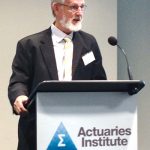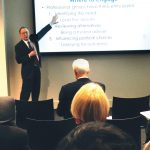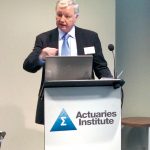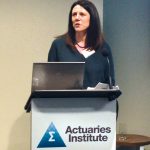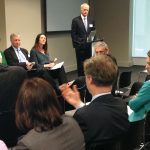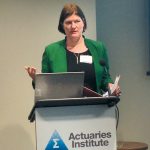
Inaugural Public Policy Forum
The Institute hosted its first Public Policy Forum on 3 November 2014. Chaired by CEO David Bell the program featured a mix of high calibre external and internal speakers and attracted an audience of 50 members. The aim of the exercise was to explore the profession’s role in public policy.
David Bell opened the Forum by providing some context as to why the Institute sees public policy as a key plank of its overall strategy. David explained that the Institute’s ‘vision’ is to position the profession as a source of valued advice and authoritative comment. That positioning aims to enhance the actuary ‘brand’ and raise the reputation of the profession. Our public policy work supports those ambitions.
It was also explained that Council wants to create awareness about the expertise of actuaries and increase demand for their skills in traditional practice areas and emerging fields. But engaging in public policy research and debates has broader objectives.
David stressed that actuaries can make a difference by bringing their expertise and professionalism to bear on important issues to drive better outcomes for all key stakeholders – business, policymakers, the public and the profession.
Two distinguished public policymakers were introduced to further set the context for public policy engagement. Tony Cole AO is a former Secretary of Treasury and of Health. Tony also served on the boards of the Reserve and Commonwealth Banks and was Chairman of the Industry Assistance Commission. He was at the forefront of economic reform in the 1980s and 1990s which saw the deregulation of the economy and the advent of compulsory superannuation.
Tony emphasised the power of economic policy to change the wellbeing of societies. Citing the economic rise of China, Australian tax reform and industry deregulation Tony made some salient points about public policy: changes in policy can have dramatic transformational impacts; important change always takes time; and, to effect change you must be armed with a well researched empirically based case.
China’s dramatic economic rise had its seeds in economic policy proposals first floated in the 1950s by Arthur Lewis around agricultural de-collectivisation that advocated the transfer of low paid rural workers to urban manufacturing. It took until 1978 for China to implement these policies under the ‘Reform and Opening Up’ programs which put that country on its rapid growth path.
Similarly, significant tax reform in Australia commenced through the Commonwealth Taxation Review (1972 – 1975) undertaken by the Asprey Committee. Some of its major recommendations did not come to fruition until 1994. A similar timeframe could apply to the Henry Review.
Dr Rod Maddock is a Professor of Economics at Monash and Victoria universities. He was formerly the Chief Economist for the Business Council of Australia and an economic adviser to the Victorian Government. Rod also headed up the Commonwealth Bank strategy team.
Rod raised some fundamental questions that the profession should answer to justify why it should engage in public policy debates. Firstly, do actuaries want to make Australia a better place? Does the profession believe that public policy is important? And finally, do actuaries believe they can add a professional perspective that can improve policy design?
If we answer yes to all three and we do want to engage in public policy then we need to understand the mechanics of engagement such as how a policy ‘need’ emerges and the role of Ministers, Cabinet and the bureaucracy.
Rod advised that a professional group has three entry points to policy debates – it can identify the need and lead the debate as we did with longevity risk. We can review government policy to improve its efficiency and/or effectiveness thus becoming a ‘trusted adviser’. Thirdly, we can seek to influence political choices by lobbying for outcomes.
Given the actuaries’ areas of expertise and the limited resources of any professional body it is crucial to identify and define those issues that the Institute is willing to engage on such as post-retirement income, natural disaster funding and health insurance.
Having selected its key issues the profession needs to argue consistently and regularly on those topics, to build trust with policymakers and engage with them on a regular basis. This requires commitment and perseverance.
The second session of the Forum featured Michael Rice, Sophie Dyson and Christine Brownfield giving updates and seeking feedback on policy projects that they are undertaking.
Michael Rice discussed whether the superannuation system is meeting its objectives. His analysis raises real concerns about the efficacy of current policy settings. Michael outlined the structure of the current system which is focussed on the accumulation phase with less emphasis placed on the adequacy retirement income levels.
The spectrum of retirement risk was outlined and included; investment, management, longevity, inflation, liquidity, budgeting and health. All these elements posed questions for retirees and many have difficulty resolving them.
Michael also contradicted some myths about retirement; Australian retirees are not wasteful and look to protect their lump sums; income products are increasingly popular; we need to increase growth assets to counter longevity risk and modest incomes are achievable. However, given the size and complexity of the superannuation system and the significant demographic changes taking place there is some doubt about the system’s ability to deliver adequate retirement incomes in the longer term.
Sophie gave a sketch of the Institute’s Green Paper on health funding that has just recently been released. It highlights the spiralling cost of health and the growing funding/benefit imbalance between cohorts. Forecasts by the Productivity Commission (2013) indicate that spending on healthcare across all levels of government will grow over the next 50 years, from 6.5% to 10.8% of GDP.
This will be by far the most significant change in government expenditure in the coming decades. Healthcare, already
the single biggest item on governments’ budgets, will take a much larger share in the future. It also appears that per capita health expenditure is growing faster in the older age groups, which will exacerbate the health expenditure effects of population ageing. Funding these increases will place a heavy burden on working Australians without some policy response by governments.
The Financial System Inquiry has raised questions about the development of products to help retirees access the equity in their homes. Christine Brownfield outlined a compelling argument for future retirees to access their equity in the family home to cope with retirement income and health cost pressures. This would add a 4th pillar to our current retirement income system. Options for releasing equity include selling the home, downsizing, reverse mortgages and home reversion products.
Housing wealth is significant for most senior Australians. The residential property market is the largest asset class and there are high rates of ownership (85% for those over 75 years). Significantly there are an increasing number of retirees with housing debt that needs to be serviced or extinguished.
Christine argued that releasing home equity is an option for managing that debt, enhancing retirement income
levels, reducing government expenditure and improving intergenerational equity. Nevertheless, policy issues need to be worked through particularly if the family home should be included in the age pension assets test. There are possible downsides to some products that could negatively affect retirees and these need to be examined carefully by policymakers.
One of the highlights of the Forum was the lively Q&A session that followed the speakers’ presentations. There was significant interest expressed in intergenerational issues and a clear desire for increased activity by the profession in the public policy space. Future Forums have also been foreshadowed.
CPD: Actuaries Institute Members can claim two CPD points for every hour of reading articles on Actuaries Digital.


